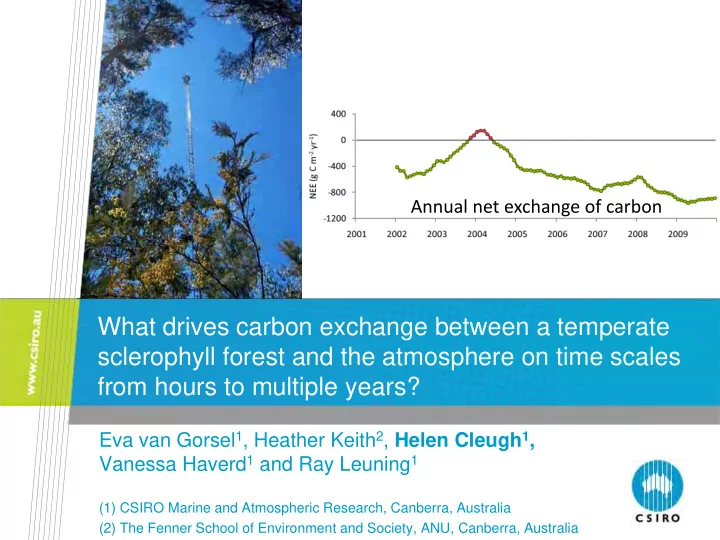

Annual net exchange of carbon What drives carbon exchange between a temperate sclerophyll forest and the atmosphere on time scales from hours to multiple years? Eva van Gorsel 1 , Heather Keith 2 , Helen Cleugh 1 , Vanessa Haverd 1 and Ray Leuning 1 (1) CSIRO Marine and Atmospheric Research, Canberra, Australia (2) The Fenner School of Environment and Society, ANU, Canberra, Australia
Variability of NEE, FLUXNET Published measurements of annual net ecosystem exchange of CO 2 (NEE) in a range of global ecosystems Tumbarumba min: -963 g C m -2 yr -1 Carbon uptake max: 145 g C m -2 yr -1 Carbon efflux From: D. Baldocchi , 2008, Aust. J. of Botany CSIRO. TEMPORAL VARIABILITY IN CO2 EXCHANGE
Tumbarumba Site: Part of OzFlux Tumbarumba Flux Tower in SE highlands of NSW Bago State Forest OzFlux CSIRO. TEMPORAL VARIABILITY IN CO2 EXCHANGE
Tumbarumba Site: Topography Photographs : Dale Hughes • 40 m tall Eucalypt forest with a Leaf Area Index ~ 2.4 • Alpine Ash E. Delegatensis • Mountain White Gum E. dalrympleana • Forest cover and species homogenous within radius > 5 km • Shallow basin sloping towards North CSIRO. TEMPORAL VARIABILITY IN CO2 EXCHANGE
Measuring ecosystem water and carbon fluxes ET ET Q H • Direct measure of CO 2 and water Q vapour fluxes between the canopy NEE and the atmosphere –Water ( λ E, ET) and CO 2 (NEE) • Energy fluxes –Radiation (Q) and heat (H, G) • Above canopy, spatially-averaged over an area ~ 1 – 5 km • Continuous – hourly to multi-annual G
Climate at Bago State Forest (AWAP data) 1380 mm 22.7 °C -1.09 °C CSIRO. TEMPORAL VARIABILITY IN CO2 EXCHANGE
Temperature / precipitation measured at site CSIRO. TEMPORAL VARIABILITY IN CO2 EXCHANGE
Ecosystem carbon fluxes vary in response to these meteorological drivers …. CSIRO. TEMPORAL VARIABILITY IN CO2 EXCHANGE
.. and also disturbance Leaves damaged by insect attack (psyllids) in summer 2002 – 03; severely damaged leaves shed in autumn 2003 2006 2002 J. Verbesselt et al. , 2010, Forest Ecol. Manag. CSIRO. TEMPORAL VARIABILITY IN CO2 EXCHANGE
Modelling net ecosystem exchange of CO 2 (NEE) Hyperbolic light-response curve (Michaelis-Menten) canopy light utilization efficiency ( μ mol C J -1 ) � b maximum CO 2 uptake rate of canopy at light saturation ( μ mol C m -2 s -1 ) terrestrial ecosystem respiration ( μ mol C m -2 s -1 ) �
Modelling net ecosystem exchange of CO 2 (NEE) include temperature dependence of respiration include dependence on vapour pressure deficit (VPD) 30 day moving window CSIRO. TEMPORAL VARIABILITY IN CO2 EXCHANGE
Model performance Captures diurnal variability … CSIRO. TEMPORAL VARIABILITY IN CO2 EXCHANGE
Model performance This means that we can use this model to quantify the effect of each of the meteorological drivers on the components of the carbon cycle (GPP, RE and NEE) CSIRO. TEMPORAL VARIABILITY IN CO2 EXCHANGE
Ecosystem assimilation (GPP) 2001-2009 CSIRO. TEMPORAL VARIABILITY IN CO2 EXCHANGE
Ecosystem assimilation (GPP) 2001-2009 CSIRO. TEMPORAL VARIABILITY IN CO2 EXCHANGE
Ecosystem respiration (RE) 2001-2009 CSIRO. TEMPORAL VARIABILITY IN CO2 EXCHANGE
NEE, GPP and RE CSIRO. TEMPORAL VARIABILITY IN CO2 EXCHANGE
Timescales of variability: Drivers and fluxes [2002-2009] vapour pressure deficit soil water content shortwave incoming radiation leaf area index soil temperature CSIRO. TEMPORAL VARIABILITY IN CO2 EXCHANGE
Timescales of variability: Drivers and fluxes [2002-2009] shortwave incoming radiation soil temperature vapour pressure deficit soil water content leaf area index CSIRO. TEMPORAL VARIABILITY IN CO2 EXCHANGE
Conclusions / Summary (1) Highly dynamic forest ecosystem where the CO 2 fluxes: Respond mainly to the meteorological drivers: • radiation and soil temperature [hourly] • radiation and SWC [seasonal] • VPD, SWC and radiation [annual] • LAI and SWC [multi annual] Are subject to stress caused by meteorological drivers • Drought (low soil moisture → RE / high VPD → GPP) • Disturbance – insect predation that is linked to antecedent weather conditions → GPP CSIRO. TEMPORAL VARIABILITY IN CO2 EXCHANGE
Conclusions / Summary (2) The response to these combined stressors resulted in: • reduced leaf area • reduced stomatal conductance and photosynthetic capacity • reduced assimilation • reduced biomass increment • increased mortality Effect of disturbance (insects) on ecosystem assimilation is greater than on ecosystem respiration Carbon sink turned to a source for several months CSIRO. TEMPORAL VARIABILITY IN CO2 EXCHANGE
CSIRO Marine and Atmospheric Research Helen Cleugh Email: helen.cleugh@csiro.au Web: www.cmar.csiro.au Thank you Contact Us Phone: 1300 363 400 or +61 3 9545 2176 Email: enquiries@csiro.au Web: www.csiro.au
… as does tree mortality 1998 – 2001 average rainfall 2002 – 2005 drought years CSIRO. TEMPORAL VARIABILITY IN CO2 EXCHANGE
… and biomass increment drought years average rainfall CSIRO. TEMPORAL VARIABILITY IN CO2 EXCHANGE
Recommend
More recommend